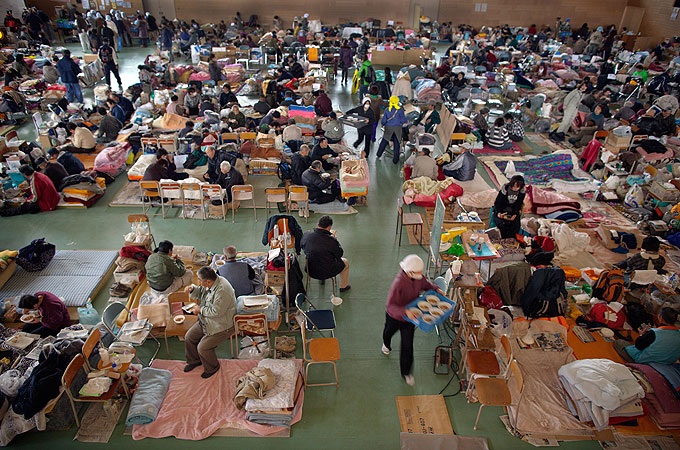Power cables reach Japan’s nuclear plant
External power lines connected to quake-stricken facilities to help cooling as fears raised over radiation in seawater.

 |
| Technicians working inside an evacuation zone around the plant have attached power cables to all reactors [Reuters] |
Power lines to all six nuclear reactor units at Japan’s quake-stricken Fukushima Daiichi complex have been connected, its operator said, but electricity has not yet been turned on.
Tokyo Electric Power Co (TEPCO) warned on Tuesday that equipment still had to be checked before power could be properly reconnected, which would mark a significant step in bringing the reactors back under control.
Keep reading
list of 4 itemsCould shipping containers be the answer to Ghana’s housing crisis?
Thousands protest against over-tourism in Spain’s Canary Islands
Holding Up the Sky: Saving the Indigenous Yanomami tribe in Brazil’s Amazon
Engineers have also been able to cool a spent fuel pool that was nearly boiling, bringing it back to 105 degrees after dumping 18 tonnes of seawater into a holding pool.
However fears have been raised over the possibility of radiation in seawater near the reactors in northeastern Japan, with reports that some radioactivity has been detected in the sea.
Experts are concerned about sea water that has been used to cool the reactors and their spend fuel ponds after the 9.0 magnitude earthquake and subsequent tsunami on March 11.
Radioactive iodine in the sea samples was 126.7 times the allowed limit, while caesium was 24.8 times over, Kyodo news agency said. But TEPCO said that still posed no immediate danger.
“I’m interested to know how this water is being disposed… if it is being disposed or just allowed to drain to sea,” Najmedin Meshkati, a nuclear and environmental expert at the University of Southern California, told the Reuters news agency.
“This is now radioactive waste water. Has there been any measurement of its radiation effect?”
Officials have acknowledged that some of the water used to cool the reactors spilled back into sea.
Hidehiko Nishiyama, deputy director-general at the Nuclear and Industrial Safety Agency, said the radioactivity in the sea could be both from water used to cool the plant and airborne particles from the reactors.
“Personally, I think the latter is more likely,” he told a news conference.
Food scares
It is not clear whether radioactivity could affect seafood, but the local fishing industry has already been ruined by the quake and tsunami.
 |
| The quake-triggered tsunami left more than 350,000 homeless [GALLO/GETTY] |
“There are no fish coming from the regions that were hit, so no fish [being sold] are contaminated,” Rika Tatsuki of the National Federation of Fisheries Cooperative Associations was quoted by Reuters.
Growing concerns about radiation add to the chain of disasters Japan has struggled with since the quake devastated the country.
There is mounting evidence of radiation in vegetables, water and milk causing the government to ban sale of raw milk, spinach and canola from prefectures over a swathe of land from the plant towards Tokyo. Above-safety radiation levels have been discovered in 11 types of vegetables in all in the area around the Fukushima plant.
The government has also started to test fish and shellfish, while Naoto Kan, the Japanese prime minister, has said that people in Fukushima prefecture should stop eating leafy vegetables and halt shipments of milk and parsley, the Kyodo news agency reported.
China, Japan’s biggest trading partner, ordered testing of Japanese food imports for radiation contamination and the World Health Organisation (WHO) said Japan will have to do more to reassure the public about food safety.
WHO said Japan needs to act quickly and ban food sales from areas around the damaged Fukushima nuclear plant if the food there is found to contain excessive levels of radiation.
The scare comes after workers at the nuclear plant were briefly evacuated after clouds of what was thought to be either smoke or steam were seen rising from the complex.
TEPCO later said on Tuesday that the smoke had turned to steam and it was deemed safe to continue work in bringing the plant under control.
Japan’s nuclear safety agency said steam was believed to be coming off a spent nuclear fuel pool at reactor No.2, and white haze was detected above reactor No. 3.
Al Jazeera’s Andrew Thomas, reporting from the city of Morioka, said it remained unclear on Tuesday morning what had caused the smoke.
“TEPCO, the company that runs the plant, say they’re not too concerned,” he said. “They say radiation levels seem to be stable and that smoke may just have been a bit of an aberration.”
Death toll rising
Damage from the earthquake and tsunami is estimated at $250bn, making it the world’s costliest natural disaster.
The official death toll has exceeded 9,400 but with 14,716 people reported missing, it is certain to rise.
The quake and tsunami obliterated towns, which are now wastelands of mud and debris, leaving more than 350,000 people homeless.
In one devastated northern town, Rikuzentakata, rebuilding has begun. Steel structures, with walls and wood floors, have been erected at a hilltop school, to provide temporary housing.
Francis Markus, an official with the Red Cross and Red Crescent Society, told Al Jazeera that getting the required aid to evacuation centres was “very challenging”, but that the situation is improving.
Robert Gates, the US defence secretary, meanwhile, has said that he is “very concerned about the health” of US military personnel currently conducting relief work in Japan.